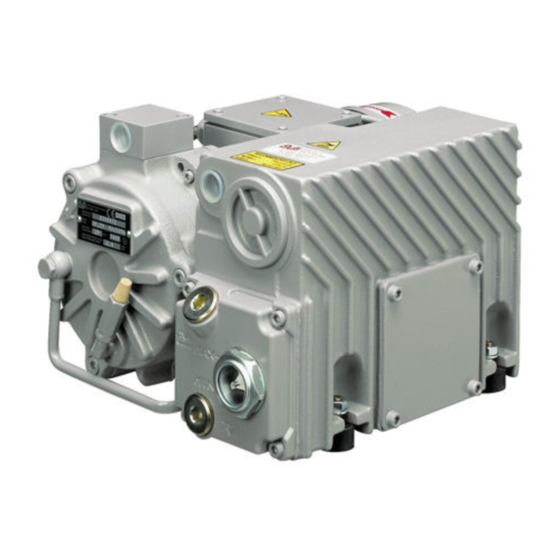Table of Contents
Advertisement
8702013 (I, GB, D, E) 17/05/2007 - R.2
MANUALE D'USO E MANUTENZIONE
(I)
OPERATING AND MAINTENANCE INSTRUCTIONS
(GB)
BETRIEBS-UND WARTUNGSANLEITUNG
(D)
MANUAL DE USO Y MANTENIMIENTO
(E)
LV.25
LB.25
POMPE PER VUOTO LUBRIFICATE A RICIRCOLO
VACUUM PUMPS WITH RECIRCULATING LUBRICATION SYSTEM
ÖLUMLAUFGESCHMIERTE VAKUUMPUMPEN
BOMBAS PARA VACIO LUBRIFICADAS A RECIRCULACION
UND FKM-AUFÜHRUNGEN / Y VERSIONES FKM
LB.40 – LB.60
LB.40
LB.60
E VERSIONI IN FKM / AND FKM VERSIONS
LV.25
D.V.P. Vacuum Technology s.r.l.
Via Rubizzano 627, 40018 S. Pietro in Casale (BO) ITALY
Tel +39 051 188.971.11
http://www.dvp.it
LC.105
LC.150
LC.205 – LC.305
Fax +39 051 188.971.70
e-mail:info@dvp.it
LC.205
LC.305
LB.25
LC.105 – LC.150
Advertisement
Table of Contents

Summarization of Contents
Introduction
Scope
Outlines procedures for pump unpacking, installation, operation, maintenance, storage, and disposal.
Product Specifications
Electrical Characteristics
Details electrical characteristics of the pump as reported on the motor rating plate.
Pump Specifications
Provides further pump specifications as detailed in the technical data table.
Installation
Unpacking
Instructions for checking the pump's condition after unpacking and reporting any damage.
Motor Installation
Guidance on selecting and installing electric or hydraulic motors with compatible flanges and shafts.
User System
Ensures the user system is free from contaminants and discusses vacuum maintenance during pump stops.
Positioning
Recommends using appropriate lifting equipment secured to the eyebolt for safe pump handling.
Filling the Tank
Details on how to fill the oil tank, emphasizing maximum level and recommended oil type.
Wiring
Covers electrical connection requirements, supply voltage checks, and rotation direction verification.
Intake and Outlet Connections
Prohibits intake of hazardous gases and provides guidelines for pipe connections and filtration.
Electrical Oil Level Gauge
Explains the function of the electrical oil level gauge and its role in signaling low oil levels.
Usage
Allowed Intake Flux
Specifies permissible gases, temperature ranges, and limitations for pump operation.
FKM Version
Describes the FKM version's suitability for aggressive gases and advises consulting the manufacturer.
Start-up
Provides critical start-up procedures, including checking for obstructions and potential operational issues.
Power Off
Recommends running the pump with a closed intake for 30 minutes before powering off to prevent rotor oxidation.
Maintenance
General Information
Emphasizes safety precautions, including disconnecting power and ensuring operator training.
Scheduled Maintenance
Presents a table outlining maintenance tasks and their recommended intervals for optimal pump performance.
How to Check Oil
Guides on inspecting the oil level and condition, identifying contamination signs.
How to Change Oil
Provides step-by-step instructions for draining and refilling the pump's oil reservoir.
Cleaning
Instructions for cleaning the radiator, fan guard, and pump using compressed air and a dry cloth.
Air Exhaust Filter Replacement
States that instructions for replacing the air exhaust filter are available upon request.
Oil Filter Replacement
Indicates that instructions for oil filter replacement are available upon request.
Vane Replacement
Notes that instructions for vane replacement are available upon request.
Troubleshooting
Offers guidance on diagnosing and resolving common pump malfunctions and when to contact service.
Storage, Transport and Disposal
Storage
Procedures for cleaning, filling with oil, and storing the pump in a suitable environment.
Transport
Guidance on preparing the pump for transport, including covering and temperature considerations.
Disposal
Advises on disposing of the pump in compliance with local and national environmental regulations.









Need help?
Do you have a question about the LC.105 and is the answer not in the manual?
Questions and answers